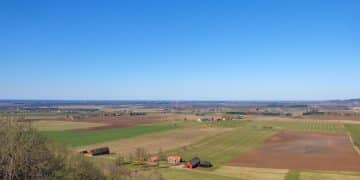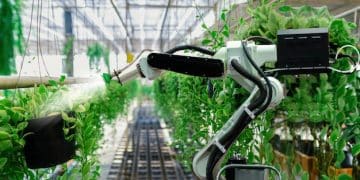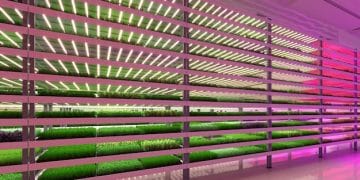Vertical Farming in the US: ROI and Energy Efficiency Analysis
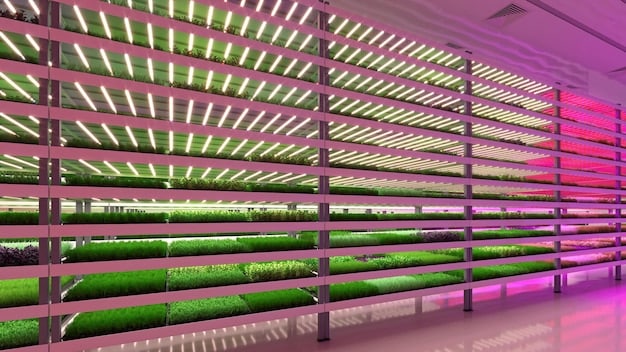
Vertical farming in the US presents a promising solution to food production challenges, but its economic viability hinges on a thorough analysis of return on investment (ROI) and energy efficiency, considering factors like initial costs, operational expenses, and potential yields.
Vertical farming in the US: A Data-Driven Analysis of ROI and Energy Efficiency is crucial for understanding the potential of this innovative agricultural practice. This article delves into the financial and environmental aspects, providing valuable insights for investors, farmers, and policymakers interested in sustainable food production.
Understanding Vertical Farming’s Potential in the US
Vertical farming, a method of growing crops in vertically stacked layers indoors, has gained considerable attention as a potential solution to food security challenges in the United States. By controlling environmental factors such as temperature, humidity, and lighting, vertical farms can optimize plant growth and significantly increase yields compared to traditional agriculture. This section explores the fundamental aspects of vertical farming and its potential to transform the agricultural landscape in the US.
What is Vertical Farming?
Essentially, vertical farming is indoor agriculture that maximizes space by stacking growing layers. This approach allows for higher yields in a smaller footprint and can be implemented in urban areas or regions with limited arable land.
Benefits of Vertical Farming
Vertical farming offers numerous advantages over conventional farming methods. These include reduced water consumption, minimized pesticide use, year-round crop production, and decreased transportation costs. By bringing food production closer to consumers, vertical farms can also contribute to reducing the carbon footprint associated with the agriculture industry.
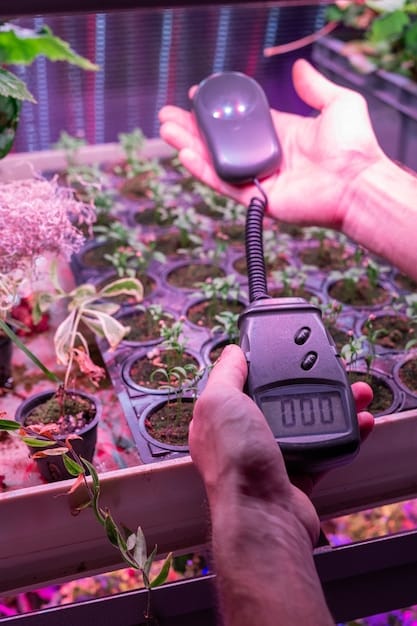
However, the widespread adoption of vertical farming is not without its challenges. High initial investment costs, energy consumption, and technological complexities are barriers that need to be addressed. The following list details some key benefits:
- Increased crop yields per square foot.
- Year-round crop production independent of weather conditions.
- Significant reduction in water usage compared to traditional agriculture.
- Reduced or eliminated pesticide and herbicide use.
In conclusion, vertical farming presents a promising pathway towards a more sustainable and efficient food system in the United States. It is essential to carefully examine the ROI and energy efficiency factors to ensure the long-term viability and success of these agricultural ventures.
Analyzing the Return on Investment (ROI)
One of the most critical aspects of evaluating the feasibility of vertical farming projects is the ROI. This involves carefully considering all the costs associated with establishing and operating a vertical farm and comparing them to the potential revenue generated from crop sales. Factors such as initial capital investments, operating expenses, and market demand all play a significant role in determining the profitability of these ventures.
Calculating Initial Investment Costs
The initial investment for a vertical farm can be substantial. This includes the cost of land or building, construction or retrofitting expenses, specialized equipment such as LED lighting systems and hydroponic or aeroponic systems, and environmental control systems like HVAC. Proper project planning and cost estimation are essential to avoid budget overruns and ensure a realistic assessment of financial viability.
Operational Expenses
Beyond the initial investment, operating expenses must be factored into the ROI calculation. These costs include energy consumption, labor, water, nutrients, packaging, and marketing. Optimizing energy usage and streamlining labor processes are crucial for reducing operational costs and improving profitability.
To properly analyze the ROI it’s important to consider the following elements:
- Market analysis to determine demand and pricing for crops.
- Financial modeling to project potential revenue and expenses.
- Sensitivity analysis to assess the impact of various factors on profitability.
- Risk assessment to identify and mitigate potential challenges.
In summary, a comprehensive ROI analysis is essential for making informed decisions about investing in vertical farming projects. By carefully evaluating all relevant costs and revenue streams, investors can gain a clear understanding of the financial viability and potential returns of these innovative agricultural ventures.
Energy Efficiency in Vertical Farming Operations
Energy efficiency is a critical consideration for the sustainability and profitability of vertical farming. The high energy demands of indoor growing environments, particularly for lighting and climate control, can significantly impact operational costs and environmental footprint. This section explores strategies for optimizing energy usage and reducing the environmental impact of vertical farming operations.
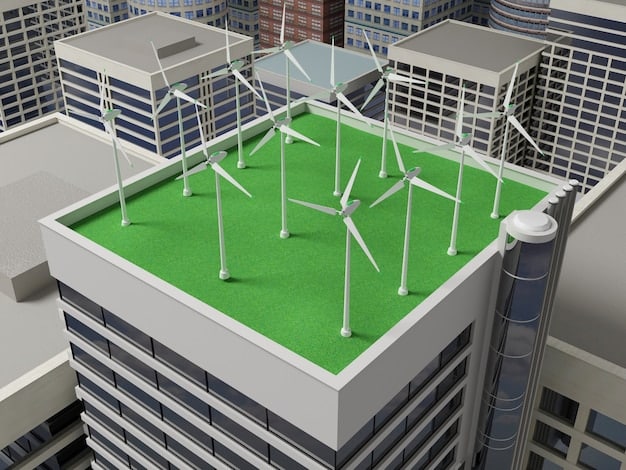
Optimizing Lighting Systems
Lighting accounts for a significant portion of energy consumption in vertical farms. Switching to more efficient LED lighting systems, implementing dynamic lighting controls, and optimizing light spectrum for specific crops can substantially reduce energy costs. Moreover, natural light integration, where feasible, can also contribute to energy savings.
Improving Climate Control Systems
Maintaining optimal temperature and humidity levels within vertical farms requires sophisticated climate control systems. Implementing energy-efficient HVAC technologies, optimizing insulation, and using heat recovery systems can minimize energy consumption while ensuring ideal growing conditions.
Here are actionable steps to improve energy efficiency:
- Utilize renewable energy sources like solar and wind power.
- Implement energy-efficient HVAC and lighting systems.
- Optimize insulation and greenhouse design to minimize energy loss.
- Employ smart control systems to monitor and regulate environmental conditions.
In short, focusing on optimizing energy consumption and implementing energy-efficient technologies is crucial for improving the economic viability and environmental sustainability of vertical farming. By embracing these strategies, vertical farms can achieve cost-effective operations and contribute to a greener future.
The Impact of Technology on Efficiency
Technology plays a pivotal role in enhancing efficiency and productivity within vertical farming. Advancements in automation, data analytics, and sensor technologies are enabling vertical farms to optimize resource utilization, improve crop yields, and reduce operating costs. This section examines how these technologies are transforming the vertical farming industry.
Automation and Robotics
Automated systems and robotics are revolutionizing vertical farming by streamlining processes such as planting, harvesting, and material handling. These technologies minimize labor costs, improve accuracy, and increase overall efficiency.
Data Analytics and IoT
The Internet of Things (IoT) and data analytics enable vertical farms to monitor and control environmental conditions in real-time. Sensors collect data on temperature, humidity, light levels, and nutrient levels, which are then analyzed to optimize growing parameters and improve crop quality. This data-driven approach ensures that resources are used efficiently, and crop yields are maximized.
To properly leverage technology it’s important to consider these points:
- Implementing advanced sensor networks to monitor environmental conditions.
- Using data analytics to optimize resource allocation and crop management.
- Employing automation and robotics to reduce labor costs.
- Leveraging AI to forecast yields and improve operational efficiency.
In conclusion, technology is a driving force behind the efficiency gains and cost reductions in vertical farming. By embracing these technological advancements, vertical farms can achieve higher levels of productivity, sustainability, and profitability.
Case Studies: Successful Vertical Farms in the US
Examining real-world examples of successful vertical farms in the US can provide valuable insights into best practices, strategies, and potential challenges. Several vertical farms have demonstrated the economic viability and environmental benefits of this innovative approach to agriculture. This section highlights some notable case studies that showcase the potential of vertical farming in the US.
Gotham Greens
Gotham Greens operates several commercial-scale vertical farms on rooftops in New York City and other urban locations. By growing crops in close proximity to consumers, Gotham Greens reduces transportation costs and delivers fresh, locally grown produce to urban communities.
Plenty
Plenty is a technology-driven vertical farming company that utilizes advanced robotics and AI to optimize crop yields and resource utilization. With a focus on leafy greens and herbs, Plenty is developing large-scale vertical farms in various locations across the US.
A few examples of keys to success are:
- Strategic location in urban areas to minimize transportation costs.
- Utilization of advanced technology to optimize crop yields and resource efficiency.
- Strong focus on sustainability and environmental stewardship.
- Effective marketing and branding to promote locally grown, fresh produce.
In summary, these case studies demonstrate that vertical farming can be a successful and sustainable agricultural model in the US. By adopting innovative technologies, optimizing resource utilization, and focusing on market demand, vertical farms can achieve profitability and contribute to a more resilient and sustainable food system.
Navigating Challenges and Future Trends
Despite its potential, vertical farming also faces several challenges, including high initial investment costs, energy consumption, and technological complexities. Overcoming these challenges requires innovative solutions, supportive policies, and collaboration among stakeholders. This section discusses the key challenges and explores future trends that could shape the vertical farming industry.
Addressing High Initial Costs
Reducing the initial investment costs of vertical farms is crucial for making this technology more accessible to a wider range of entrepreneurs and investors. This can be achieved through government incentives, technological innovation, and economies of scale.
Minimizing Energy Consumption
Optimizing energy usage is essential for the sustainability of vertical farming operations. This can be achieved through the integration of renewable energy sources, the implementation of energy-efficient technologies, and the development of innovative lighting and climate control systems.
The key elements for addressing challenges and following trends are:
- Government support through subsidies and research funding.
- Technological innovation to reduce costs and improve efficiency.
- Collaboration among researchers, farmers, and policymakers.
- Consumer education to promote the benefits of vertical farming.
In short, while challenges remain, the future of vertical farming in the US looks promising. By addressing these challenges and embracing emerging trends, vertical farming can play a significant role in creating a more sustainable, resilient, and equitable food system.
| Key Point | Brief Description |
|---|---|
| 🌱 ROI Analysis | Evaluating costs vs. revenue to determine profitability. |
| ⚡ Energy Efficiency | Minimizing energy usage to reduce operational costs and environmental impact. |
| 🤖 Technology Impact | Automation and IoT optimizing resource utilization and crop yields. |
| 🏢 Case Studies | Examining successful vertical farms in the US for best practices. |
Frequently Asked Questions
▼
The ROI varies depending on factors like initial investment, operating costs, and crop yields. A comprehensive financial analysis is essential. Some farms achieve profitability within a few years, while others may take longer.
▼
Vertical farming can be more energy-efficient in certain aspects like water usage and reduced transportation. However, the high energy demands for lighting and climate control can offset these gains, necessitating energy-efficient technologies.
▼
Automation, IoT, and data analytics play a crucial role. Advanced sensor networks monitor environmental conditions, while AI optimizes resource allocation and crop management. Robotics can also reduce labor costs.
▼
High initial investment costs, energy consumption, and technological complexities are significant hurdles. Reducing costs, optimizing energy usage, and improving access to funding are key to overcoming these challenges.
▼
Future trends include increased integration of renewable energy, advancements in LED lighting technology, and the development of more efficient climate control systems. Government support and consumer education will also play a vital role.
Conclusion
In conclusion, vertical farming in the US presents both significant opportunities and challenges. While the potential for increased yields, reduced water usage, and localized food production is compelling, the need for careful ROI analysis and energy efficiency optimization is crucial for long-term success. Embracing technological advancements and fostering collaboration among stakeholders are essential for realizing the full potential of vertical farming and creating a more sustainable and resilient food system in the United States.
